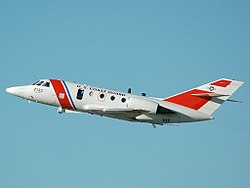U.S. Coast Guard.
Today is the 235th anniversary of the circa 1790 founding of Alexander Hamilton’s old Revenue Cutter Service/Revenue Marine, which became today’s U.S. Coast Guard.
It is also the rough 35th anniversary of the beginning of the USCG’s continuing service in the Arabian and Persian Gulfs, which is about 6,700 miles as the crow flies from the continental U.S.

 laststandonzombieisland.com
laststandonzombieisland.com

When Saddam ordered scorched earth on the Kuwait oilfields during the liberation, on 13 February 1991, two USCG HU-25A Falcon jets, equipped with AIREYE side airborne looking radar (SILAR) and oil detection equipment, flew from Air Station Cape Cod to Saudi Arabia, supported by two Coast Guard HC-130 Hercules cargo aircraft from Air Station Clearwater packed with ground crew, spare aviation parts and support packages.

The Falcons were deployed for 84 days and mapped over 40,000 square miles of the Persian Gulf. They logged 427 flight hours in the region and maintained an aircraft readiness rate of over 96 percent. These flights provided daily updates on the size and direction of the spill.
Today is the 235th anniversary of the circa 1790 founding of Alexander Hamilton’s old Revenue Cutter Service/Revenue Marine, which became today’s U.S. Coast Guard.
It is also the rough 35th anniversary of the beginning of the USCG’s continuing service in the Arabian and Persian Gulfs, which is about 6,700 miles as the crow flies from the continental U.S.

Semper Paratus: Sandbox edition
Today is the 235th anniversary of the circa 1790 founding of Alexander Hamilton’s old Revenue Cutter Service/Revenue Marine, which became today’s U.S. Coast Guard. It is also the rough …
 laststandonzombieisland.com
laststandonzombieisland.com
When Saddam ordered scorched earth on the Kuwait oilfields during the liberation, on 13 February 1991, two USCG HU-25A Falcon jets, equipped with AIREYE side airborne looking radar (SILAR) and oil detection equipment, flew from Air Station Cape Cod to Saudi Arabia, supported by two Coast Guard HC-130 Hercules cargo aircraft from Air Station Clearwater packed with ground crew, spare aviation parts and support packages.
The Falcons were deployed for 84 days and mapped over 40,000 square miles of the Persian Gulf. They logged 427 flight hours in the region and maintained an aircraft readiness rate of over 96 percent. These flights provided daily updates on the size and direction of the spill.

